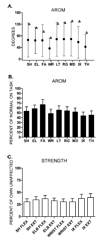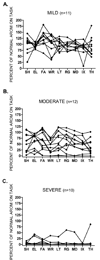Absence of a proximal to distal gradient of motor deficits in the upper extremity early after stroke
- PMID: 18571981
- PMCID: PMC2584445
- DOI: 10.1016/j.clinph.2008.04.293
Absence of a proximal to distal gradient of motor deficits in the upper extremity early after stroke
Abstract
Objective: Our first purpose was to determine whether there was a proximal to distal gradient in motor deficits in nine segments of the affected upper extremity (shoulder, elbow, forearm, wrist, and five fingers) post-stroke. Our second purpose was to determine which upper extremity segments made the greatest contributions to hand function.
Methods: Thirty-three subjects were tested on average 18.6 (+/-5.6) days after stroke. The ability to move each segment was measured by active range of motion (AROM). Hand function was measured by a battery of standardized clinical tests which were synthesized into a single, sensitive score for hand function using principal component analysis.
Results: AROM at all nine segments of the upper extremity was reduced and there was no evidence of a proximal to distal gradient in AROM values. Strength of each segment was reduced and there was also no evidence of a gradient in strength values. AROM at each segment was strongly correlated with hand function scores (range 0.76-0.94). General multiple regression analysis showed that AROM explained 82% of the variance in hand function, with most of the variance shared across proximal, middle, and distal segments. Hierarchical regression analysis showed that shoulder AROM alone could explain 88% of the variance in hand function.
Conclusions: Early after stroke a proximal to distal gradient of motor deficits was not present, and loss of hand function was due to a loss of ability to move many segments of the upper extremity and not just the distal ones.
Significance: These results suggest that a change in the clinical perception of motor deficits post-stroke is needed. Our finding that shoulder AROM predicted almost all the variance in hand function opens up the possibility that this quick, simple measure may be predictive of future hand function. This would be of high economic and clinical utility compared to other ongoing efforts attempting to predict outcomes post-stroke (e.g. fMRI, MEG).
Figures


Similar articles
-
Relating movement control at 9 upper extremity segments to loss of hand function in people with chronic hemiparesis.Neurorehabil Neural Repair. 2007 May-Jun;21(3):279-91. doi: 10.1177/1545968306296964. Epub 2007 Mar 12. Neurorehabil Neural Repair. 2007. PMID: 17353458
-
Active range of motion predicts upper extremity function 3 months after stroke.Stroke. 2009 May;40(5):1772-9. doi: 10.1161/STROKEAHA.108.536763. Epub 2009 Mar 5. Stroke. 2009. PMID: 19265051 Free PMC article.
-
Predictive ability of 2-day measurement of active range of motion on 3-mo upper-extremity motor function in people with poststroke hemiparesis.Am J Occup Ther. 2012 Jan-Feb;66(1):35-41. doi: 10.5014/ajot.2012.002683. Am J Occup Ther. 2012. PMID: 22251829 Free PMC article.
-
Effects of Kinect-based virtual reality game training on upper extremity motor recovery in chronic stroke.Somatosens Mot Res. 2018 Mar;35(1):25-32. doi: 10.1080/08990220.2018.1444599. Epub 2018 Mar 13. Somatosens Mot Res. 2018. PMID: 29529919 Clinical Trial.
-
Upper extremity strength and range of motion and their relationship to function in breast cancer survivors.Physiother Theory Pract. 2013 Oct;29(7):513-20. doi: 10.3109/09593985.2012.757683. Epub 2013 Jan 23. Physiother Theory Pract. 2013. PMID: 23343035
Cited by
-
Impairments of the arm and hand are highly correlated during subacute stroke.J Rehabil Med. 2023 May 23;55:jrm2174. doi: 10.2340/jrm.v55.2174. J Rehabil Med. 2023. PMID: 37219403 Free PMC article.
-
Pattern of improvement in upper limb pointing task kinematics after a 3-month training program with robotic assistance in stroke.J Neuroeng Rehabil. 2017 Oct 13;14(1):105. doi: 10.1186/s12984-017-0315-1. J Neuroeng Rehabil. 2017. PMID: 29029633 Free PMC article.
-
Time to reconcile research findings and clinical practice on upper limb neurorehabilitation.Front Neurol. 2022 Jul 19;13:939748. doi: 10.3389/fneur.2022.939748. eCollection 2022. Front Neurol. 2022. PMID: 35928130 Free PMC article. Review.
-
Lesion Topography Impact on Shoulder Abduction and Finger Extension Following Left and Right Hemispheric Stroke.Front Hum Neurosci. 2020 Jul 17;14:282. doi: 10.3389/fnhum.2020.00282. eCollection 2020. Front Hum Neurosci. 2020. PMID: 32765245 Free PMC article.
-
Are movement disorders and sensorimotor injuries pathologic synergies? When normal multi-joint movement synergies become pathologic.Front Hum Neurosci. 2015 Jan 6;8:1050. doi: 10.3389/fnhum.2014.01050. eCollection 2014. Front Hum Neurosci. 2015. PMID: 25610391 Free PMC article. Review.
References
-
- Agnew PJ, Maas F. Hand function related to age and sex. Archives of Physical Medicine and Rehabilitation. 1982;63:269–271. - PubMed
-
- Andrews AW, Thomas MW, Bohannon RW. Normative values for isometric muscle force measurements obtained with hand-held dynamometers. Phys Ther. 1996;76:248–259. - PubMed
-
- Bard G, Hirschberg GG. Recovery of voluntary motionin upper extremity following hemiplegia. Arch Phys Med Rehabil. 1965;46:567–567. - PubMed
-
- Beer RF, Dewald JP, Dawson ML, Rymer WZ. Target-dependent differences between free and constrained arm movements in chronic hemiparesis. Experimental Brain Research. 2004;156:458–470. - PubMed
-
- Beer RF, Dewald JP, Rymer WZ. Deficits in the coordination of multijoint arm movements in patients with hemiparesis: evidence for disturbed control of limb dynamics. Experimental Brain Research. 2000;131:305–319. - PubMed
Publication types
MeSH terms
Grants and funding
LinkOut - more resources
Full Text Sources
Medical

